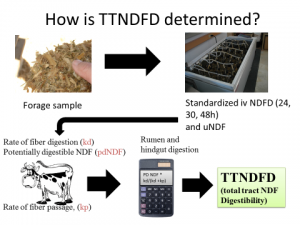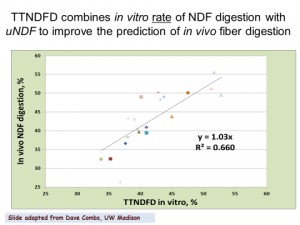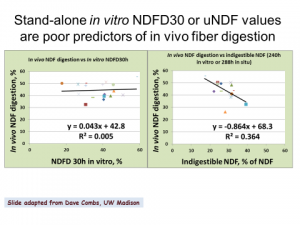Using In Vitro Total-Tract NDF Digestibility in Forage Evaluation
by Dave Combs1
1Department of Dairy Science, University of Wisconsin-Madison
Introduction
Fiber is an essential component of diets for dairy cattle. In high producing dairy cows, about a quarter of the energy for milk production comes from digested fiber. Neutral detergent fiber (NDF) is a laboratory assay done on forages to measure the total content of fiber in a feed. The NDF is a ‘bulky’, slow to digest feed component, which can restrict feed intake and milk production. Forages are analyzed for NDF content and diets for lactating dairy cows are typically formulated to contain 28% to 35% NDF on a dry matter (DM) basis depending primarily on level of milk production and the feed ingredients being used in the diet.
The digestibility of NDF also profoundly affects feed intake and milk production. Fiber digestibility can have a much greater impact on milk production than the digestibility of any other feed component. The digestibility of the fiber in 38%-NDF alfalfa can vary from 30% to over 60% of the NDF. In a dairy ration containing 15 lb. DM of this alfalfa, a doubling of fiber digestibility would increase the intake of digestible energy enough to support up to 8 to 10 lb. more milk per cow per day.
A new in vitro lab assay has been developed by UW-Madison Dairy Scientists that predicts total-tract NDF digestion in ruminants. The in vitro total-tract NDF digestibility (TTNDFD) test predicts NDF digestion for alfalfa, corn silage, grass forages and byproduct feeds. UW-Madison researchers have validated the accuracy of the in vitro TTNDFD test against directly measured NDF digestibility in lactating dairy cattle. The University of Wisconsin recently was awarded a patent for the in vitro digestibility procedure that is used in calculation of TTNDFD. This Focus on Forage paper will review the TTNDFD test and discuss its use in forage evaluation.
How is TTNDFD different from other laboratory assays?
The TTNDFD test is different from other fiber quality measures because it is a direct quantitative predictor of fiber digestion.
Other assays such as 30- or 48-hour NDF digestibility (NDFD), relative feed value (RFV), relative forage quality (RFQ), and milk per ton (Milk-2006) are used to compare the relative differences in forage quality among alfalfa varieties or corn silage hybrids. These indexes should not be used to compare forages across types which limits their value as decision-making tools for optimizing the combination of corn silage, alfalfa, and grass in dairy forage systems. These indexes also are not useful for ration formulation.
Rumen in vitro and (or) in situ NDFD assays estimate and compare fiber digestibility among forages. These assays have limited value because they measure relative, not absolute, fiber digestion. Oba and Allen (1999) reviewed several feeding studies with dairy cattle and concluded that increasing in vitro or in situ NDFD by 1%-unit was associated with 0.4 lb. increased DM intake and 0.5 lb. additional 4% fat-corrected milk yield per cow per day. The in situ or in vitro NDFD change within a study was correlated with DM intake and milk production, but there was no significant correlation between the absolute measures of fiber digestion and DM intake or milk yield across studies. One reason why absolute NDFD values across labs are poorly related to DM intake or milk production is because the procedures for running these tests differ among labs. In addition, surprisingly little work has been published to validate laboratory measures of rumen fiber digestion with observed fiber digestion in cattle.
The TTNDFD test specifically measures and accounts for several factors that influence NDF digestion. Estimates of NDF digestibility derived from the TTNDFD test have been confirmed by dairy cattle feeding trials.
How does TTNDFD work?
The TTNDFD test is designed to predict how the process of forage fiber digestion is expected to occur in high producing dairy cows. There are at least four critical factors that affect fiber digestion and the TTNDFD test accounts for each factor:
- The proportion of fiber that is potentially digestible. Forage NDF consists of two components, a potentially digestible (pdNDF) component and an indigestible (iNDF) component. The proportion of NDF that can potentially digest varies due to feed type and growing environment. On average, about 60% to 65% of the NDF in alfalfa is pdNDF. The proportion of pdNDF in corn silage is typically greater than in alfalfa: 75% to 85% of corn silage NDF is pdNDF. The proportion of NDF that is iNDF is typically estimated from very long-term rumen in situ or in vitro incubations; NDF residue remaining (undigested NDF) after a 240-hour incubation (uNDF240) is often used to estimate iNDF. The pdNDF fraction is determined by subtracting uNDF240 (% of DM) from total NDF (% of DM).
- The rate of digestion of potentially digestible NDF (kd). The rate of NDF digestion also differs due to forage type and growing environment. The pdNDF in alfalfa digests nearly twice as fast (4% to 6% per hour) as the pdNDF in corn silage (2% to 3% per hour). The TTNDFD values for alfalfa and corn silage are similar, but the process of NDF digestion is quite different between these two forages. In corn silage, there is a larger fraction of pdNDF that digests more slowly. In alfalfa, there is a smaller fraction of pdNDF that digests nearly twice as fast as corn silage pdNDF.
- The rate of passage of potentially digestible NDF through the cow (kp). Both cow size and feed intake affect the passage rates of pdNDF and iNDF. As intake goes up, the rate of passage of both fractions increases, and, as a result, NDF digestibility declines. Passage of the pdNDF fraction is also slower than passage of the iNDF fraction. The TTNDFD test specifically accounts for the kp of the pdNDF.
- Ruminal and hindgut fiber digestion. Approximately 90% to 95% of fiber digestion occurs in the rumen, but digestion beyond the rumen must be accounted for if one is to accurately predict the amount of energy derived from NDF. When both ruminal and hindgut digestion are accounted for, the TTNDFD measurement can be calculated and this digestion coefficient
can be directly validated in dairy cattle.
An accurate assessment of fiber digestion requires that these four factors be integrated into a single measurement. The TTNDFD test integrates all four of the above factors into a single value, which predicts the proportion of the total NDF that will digest between the mouth and feces or the energy from fiber that can be used to support milk production.
What is the typical variation in forage TTNDFD?
Typical TTNDFD values for corn silage, alfalfa and grasses are summarized below. The average values represent over 7,000 samples each of corn silage or alfalfa and over 1,200 grass forage samples. The means, standard deviations (SD) and ranges in TTNDFD values (Table 1) coincide with directly measured values that have been reported in dozens of controlled feeding studies published in scientific journals such as the Journal of Dairy Science.
Table 1.
Typical TTNDFD values of corn silage, alfalfa or grass*.
| Mean | SD | Range | |
| —-TTNDFD, % of NDF— | |||
| Corn Silage | 42 | ± 6 | 20-60 |
| Alfalfa | 43 | ± 7 | 30-60 |
| Grass | 47 | ± 8 | 20-80 |
Samples submitted to Rock River Laboratories, Watertown, WI.
What are NDF and TTNDFD target values for high-quality forages?
The goal for NDF and TTNDFD are dependent on forage type. The TTNDFD average values in Table 1 should be minimum goals, while Table 2 contains target values for dairy-quality forages. Alfalfa and corn silage have similar targets of <40% NDF and >48% TTNDF. Temperate grasses have more NDF, but should be more digestible with a goal of >50% TTNDFD.
Table 2.
Target values for NDF and TTNDFD
| NDF | TTNDFD | |
| Alfalfa | <40% | >48% |
| Corn silage | <40% | >48% |
| Temperate grasses | <45% | >50% |
What have TTNDFD test validation trials with lactating dairy cattle shown?
Research at the University of Wisconsin (Lopes et al. 2015) validates the accuracy of TTNDFD to predict in vivo (in the cow) NDF digestion. Figure 2 shows that TTNDFD accurately predicts in vivo NDF digestion with an R2 of 0.66. The slope of the regression line is 1.03 showing a close relationship between TTNDFD and NDF digestion in the cow. Single time-point ivNDFD and iNDF tests are poorly related to in vivo NDF digestion as shown in Figure 3.
The TTNDFD test combines iNDF with in vitro rate of NDF digestion which better predicts NDF digestion.
Guidelines for using TTNDFD
- The TTNDFD assay is intended to evaluate the digestibility of NDF of feeds and rations in animals fed an otherwise balanced diet. Inadequacies of other nutrients (protein, amino acids, minerals) or excesses of dietary components other than fiber (i.e. mycotoxins) are not accounted for in this assay.
- The TTNDFD can be used to compare fiber utilization across forage or fiber sources. For example, fiber digestibility of corn silage can be compared to fiber digestibility of alfalfa, grass or co-product feed.
- TTNDFD does not account for differences in physical form (effective fiber) of forages.
- TTNDFD estimates total tract digestibility of fiber for a dairy cow consuming about 53 lb of DM. The typical TTNDFD value of a dairy diet based on alfalfa and corn silage is 42%. A 2 to 3 unit change in TTNDFD corresponds to enough digestible energy to support a pound of milk yield.
- Total NDF and TTNDFD must be considered when comparing forages for quality. Dairy diets for high producing cows are typically formulated to contain about 28 to 30% NDF, and the TTNDFD should be at least 42%.
Summary
The key to getting the most out of forages is understanding how forage energy values are affected by NDF and NDF digestibility. The TTNDFD test is intended to be an additional tool to provide a clearer understanding of how forage fiber is utilized by dairy cattle. It is not intended to be the only tool used to evaluate forage quality or fiber utilization by dairy cattle. But it can provide valuable insights into evaluating forages and predicting animal performance.
References
Goeser, J.P., P.C. Hoffman, and D.K. Combs. 2009. Modification of a rumen fluid priming technique for measuring in vitro neutral detergent fiber digestibility. J. Dairy Sci. 92: 3842-3848.
Lopes, F., D.E. Cook, and D.K. Combs. 2015. Validation of an in vitro model for predicting rumen and total-tract fiber digestibility in dairy cows fed corn silages with different in vitro neutral detergent fiber digestibilities at 2 levels of dry matter intake. J. Dairy Sci. 98:574-585.
Lopes. F., K. Ruh, and D.K. Combs. 2015. Validation of an approach to predict total-tract fiber digestibility using a standardized in vitro technique for different diets fed to high-producing dairy cows. J. Dairy Sci. 98:2596-2602.
Lopes, F. D.E. Cook, and D.K. Combs. 2015. Effects of varying ratios of corn silage to alfalfa silage on digestion of neutral detergent fiber in lactating dairy cows. J. Dairy Sci. 98:6291-6303
Oba, M. and M.S. Allen. 1999. Evaluation of the importance of digestibility of neutral detergent fiber from forage: Effects on dry matter intake and milk yield of dairy cows. J. Dairy Sci. 82:589-596.
Acknowledgements
The author appreciates the review of the original draft of the fact sheet by R. D. Shaver and M. S. Akins of the UW Madison Dairy Science Department.
![]() © University of Wisconsin Board of Regents, 2014
© University of Wisconsin Board of Regents, 2014







